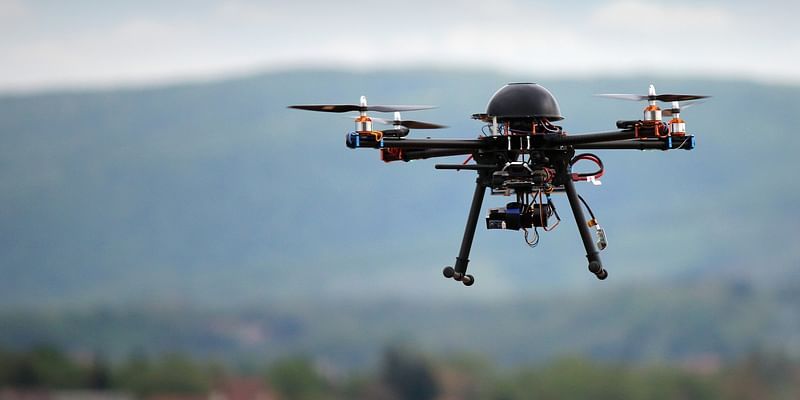
Until recently, a majority of people thought of drones as either toys or weapons of war. Since drones have developed into intelligent autonomous systems, national security strategies and billion-dollar business opportunities are emerging. These flying machines are now vital instruments for decision-making, thanks to artificial intelligence, which also helps India develop its digital future by acting as a responder.
AI-powered drones: Smarter eyes in the sky
Modern drone technology achieves its greatness by combining flight capability with cognitive operations. AI has enabled drones to develop intelligence in the form of object recognition and predictive navigation with real-time learning capabilities.
These devices maintain flight stability while performing object tracking and course adjustments, operating in areas where standard communication systems become unreliable due to GPS interference, radio signal obstruction, or harsh weather conditions.
Such operational flexibility is essential for India due to its diverse geographical landscape.
Safety: Aerial intelligence at the borders and beyond
India faces multiple national security challenges because of its extensive open borders and complex urban areas. AI drones operate in situations that can revolutionise the current security landscape through their capabilities.
AI-powered drones with thermal imaging and real-time object detection capabilities serve as border surveillance systems to monitor India's extensive territorial borders. They distinguish animals from humans while detecting heat maps and send immediate alerts to command centres with higher precision than human observers.
The development of AI drone systems is underway for urban policing and public safety operations in Delhi and Mumbai to monitor crowds and analyse faces while detecting abnormal behaviours during large events and crises. Urban intelligence and predictive policing receive an additional advancement through this system.
Drones have acted as primary emergency responders in Uttarakhand during flash floods and in Himachal Pradesh during forest fires. They conducted area scans and destruction zone mapping while performing emergency supply deliveries to inaccessible areas.
Startups such as Garuda Aerospace have deployed AI-powered drones for flood mapping and rescue operations.
The economy: From the sky to the supply chain
The use of drones with AI functions creates protection and drives business expansion. It brings significant economic changes in India’s agricultural sector, infrastructure development, and logistics operations.
AI-powered drones with multispectral sensors monitor crop health and detect pests while automating watering systems. These technologies help smallholder farmers boost their harvests while reducing their input costs.
Indian Railways, along with power companies, implements AI drone inspections for bridge infrastructure, high-tension lines, and pipeline systems. The inspection process becomes more efficient while reducing costs, together with minimising the exposure of human personnel. These drones possess deep learning features that enable them to identify small cracks and defects that human observers cannot detect.
The Indian drone industry prepares to transform last-mile delivery services for the thriving ecommerce market. Indian startup ideaForge develops drones, which serve both military and commercial delivery needs. AI-powered drones operate with self-navigating systems that select the safest optimal flight paths through changing conditions.
The big picture: Where does India stand?
The US, China, and Israel are some of the leading AI integration and R&D-led countries when it comes to drones.
Although India entered this sector late, it now shows growing momentum in the market. The country possesses top-tier software engineering expertise, while also improving its hardware development potential.
According to Invest India, the global drone market will reach $279 billion by 2030, while the Indian drone market is expected to reach $1.8 billion by 2026. The growth rate of AI-enabled drone applications exceeds 20% annually, while India ranks among the fastest-growing markets in this sector.
However, India must resolve its limited AI training datasets, insufficient drone testing facilities, and dependency on foreign drone components to achieve drone market development. The newly introduced policies demonstrate progress, yet their implementation requires further acceleration.
The Liberalised Drone Rules 2021 represented a significant advancement toward opening Indian airspace to innovative solutions. The new rules eliminated complex licensing requirements, allowing both businesses and people to use the technology. The time has come for policy vision to align with actual implementation.
A billion-dollar sky economy remains accessible
AI-powered drones have already arrived and will transform future operations instead of existing as future possibilities. They represent more than technological progress for India as they hold strategic importance for national defence and economic recovery capabilities.
The development of intelligent drone technology serves as the aerial component of India's digital infrastructure. The technology serves three main purposes, including safeguarding borders, enhancing agricultural production, and responding quickly during emergencies.
If India continues to invest in policy, innovation, and talent development, it will soon have more than just flying drones. The nation will use this power to beat the global competition.
Sai Pattabiram is the Founder and MD of Zuppa Geo Navigation Technologies.
(Disclaimer: The views and opinions expressed in this article are those of the author and do not necessarily reflect the views of YourStory.)
Original Article
(Disclaimer – This post is auto-fetched from publicly available RSS feeds. Original source: Yourstory. All rights belong to the respective publisher.)